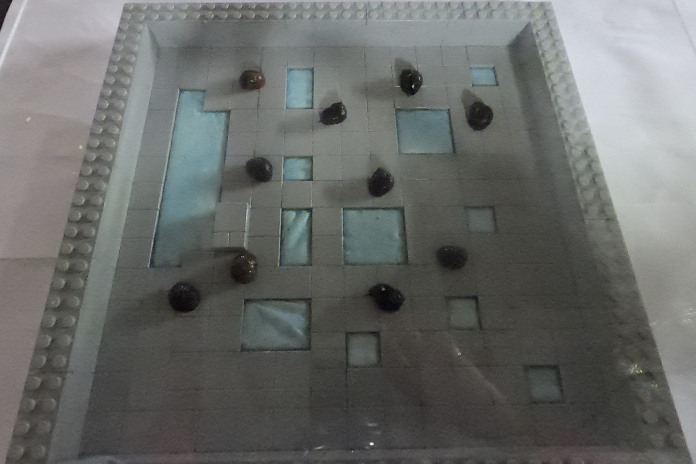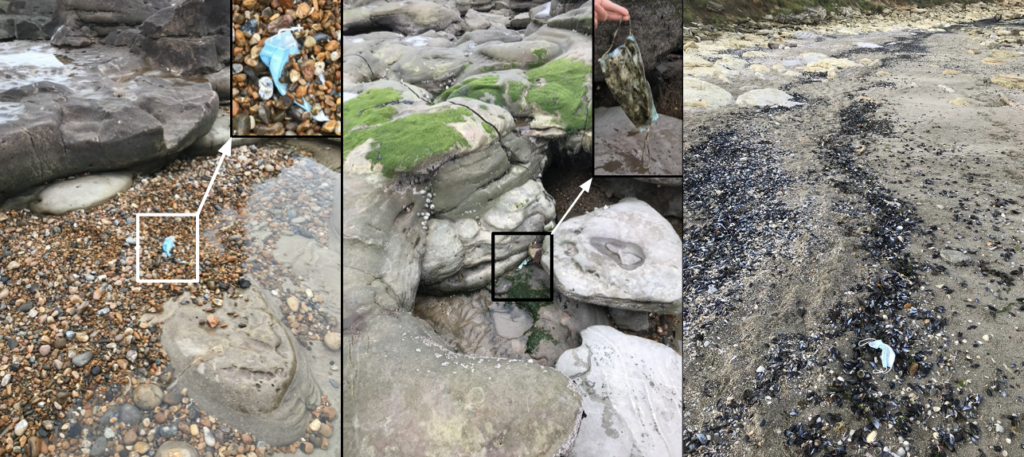1 March 2022
AGU press contact:
Liza Lester, +1 (202) 777-7494, [email protected] (UTC-5 hours)
Contact information for the researchers:
Laurent Seuront, Centre National de la Recherche Scientifique (CNRS), [email protected] (UTC+1 hour)
WASHINGTON—Disposable face masks could be harmful to wildlife, according to researchers who have observed harmful effects of the masks on keystone marine animals in coastal areas.
The researchers observed altered behaviors in tide pool animals that appear to be associated with the chemicals leaching from disposable masks. The behavioral effects include signs of stress and reduced ability to detect mates and reproduce.
The effects could have repercussions in the marine food chain, potentially cascading up to affect the seafoods humans consume, according to the researchers who will report results from their ongoing experiments on 3 March at the 2022 Ocean Sciences Meeting, being held online from 24 February through 4 March.
“We’re seeing more and more masks in rocky pools,” said Laurent Seuront, a marine ecologist at the French Centre National de la Recherche Scientifique, who will present the new research. “This could cascade up the food chain and up to us.”
The rapid proliferation of face mask litter in rocky tidal areas prompted Seuront and an international team, including K. Nicastro from CCMAR (Portugal) and G. Zardi from Rhodes University (South Africa), to study how disposable masks might be affecting keystone species at the bottom of the marine food web.
Disposable face masks are commonly made of plastic fibers, which are composed of the same plastic polymer (polypropylene) previously shown to have negative effects on aquatic organisms.
The researchers designed experiments to see how long face masks leach chemicals into water, as well as whether marine invertebrates change their behaviors when masks are present. The invertebrates in the study include small crustaceans called copepods, the blue mussel Mytilus edulis and the marine snail Littorina littorea.
Using tanks with simulated rocky surfaces and patches of face mask material, the researchers were able to observe animals’ behaviors.
Blue mussels moved away from the face mask materials, gathering together, or aggregating, in a way they typically do to avoid threats. The amount of aggregation is a measure of how stressed the mussels are, Seuront explained. In the experiments, mussels avoided the mask materials and aggregated at a rate of 70%, compared to just 30% when masks were not present.
Mussels move on a single foot and have a sensory organ (the osphradium) that allows them to essentially taste the quality of the water surrounding them, Seuront explained.
Their experiments have shown that unlike mussels, marine snails did not avoid masks and mask fragments, but consistently showed signs of behavioral stress when crawling on them and preferred uncontaminated over contaminated surfaces. The snails also showed signs of being impaired by the chemicals. They were less vigilant after being exposed to leached chemicals, which increase their likelihood to be predated, Seuront reported.
Copepods, for their part, appeared to have reproductive challenges due to exposure to the mask chemicals. Male copepods were observed to be significantly less able to detect female pheromone trails, which made it much harder and less likely they would locate females and reproduce.
The broader problem, Seuront explained, is that these and other small invertebrates feed larger animals in marine food webs. If these invertebrates are having problems because of disposable masks, the effects can spread through the food web.
“This could cascade up the food chain and up to us,” Seuront said.

Experimental set up with marine snails and areas of mask material and rocky areas simulated with Legos building blocks. Credit: Laurent Seuront, CNRS
###
More than 5,000 scientists are expected to present the latest research findings about the world’s oceans at the Ocean Sciences Meeting 2022. The biennial meeting brings together researchers from the American Geophysical Union, the Association for the Sciences of Limnology and Oceanography, and The Oceanography Society.
AGU (www.agu.org) supports 130,000 enthusiasts to experts worldwide in Earth and space sciences. Through broad and inclusive partnerships, we advance discovery and solution science that accelerate knowledge and create solutions that are ethical, unbiased and respectful of communities and their values. Our programs include serving as a scholarly publisher, convening virtual and in-person events and providing career support. We live our values in everything we do, such as our net zero energy renovated building in Washington, D.C. and our Ethics and Equity Center, which fosters a diverse and inclusive geoscience community to ensure responsible conduct.
Notes for Journalists
Laurent Seuront will be available for interviews during the meeting. Please contact him via email: [email protected]
Session information: ME07 Marine microplastics: Occurrence, transport, effects, and solutions 05, Session Format: Oral Session Thursday, 3 March, 6:00-7:00 pm ET.
Presentation abstract: Disposable COVID-19 face masks are an underpinned threat for marine ecosystems
For information about Ocean Sciences Meetings 2022, including the schedule of press events, visit the Ocean Sciences Meeting 2022 Media Center.
Neither the presentation nor this press release is under embargo.
